HOW CAN WE HELP YOU? Call 1-800-TRY-CHOP
In This Section
Scientific Symposium Emphasizes Future Directions of Research Institute
 Synapses were firing throughout the conference room in the Colket Translational Research Building as attendees at the 2017 Research Institute Scientific Symposium held May 2 learned about their colleagues’ intriguing research endeavors. The four sessions’ themes aligned smartly with the Research Institute’s strategic planning process and overall mission of the Children’s Hospital of Philadelphia.
Synapses were firing throughout the conference room in the Colket Translational Research Building as attendees at the 2017 Research Institute Scientific Symposium held May 2 learned about their colleagues’ intriguing research endeavors. The four sessions’ themes aligned smartly with the Research Institute’s strategic planning process and overall mission of the Children’s Hospital of Philadelphia.
“I’m hoping that what you’re going to hear from each session is a little bit about the really cool stuff that’s happening today, and a little bit about the really cool stuff we expect to see happening in the relatively near future,” said Stewart A. Anderson, MD, a research psychiatrist in the department of Child and Adolescent Psychiatry and Behavioral Sciences at CHOP and professor of Psychiatry in the Perelman School of Medicine at the University of Pennsylvania, in his opening comments as one of the leaders of the Symposium’s planning committee.
Innovating Along the Fetal to Adult Lifespan
And indeed, really cool stuff is exactly what the Symposium speakers delivered throughout the day, starting off with highlights of research projects that are innovating along the fetal to adult lifespan. While generally pediatric care has been most concerned with the here and now of helping a sick child, this line of research also encompasses the before and after.
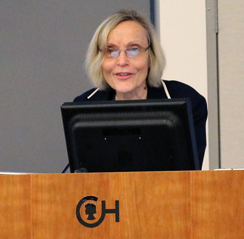
For example, Raquel Gur, MD, PhD, professor of Psychiatry Neurology and Radiology at Penn who directs the new Lifespan Brain Institute, which encompasses broad collaborations between investigators at CHOP and Penn, spoke about “The Emergence of Psychosis in Youth.” Dr. Gur explained how researchers are identifying biomarkers that could lead to new ways to predict which children will develop psychosis as they reach adolescence and young adulthood. Once researchers better understand how brain circuitry goes awry earlier in life, the next step would be to develop interventions that could help to avert a patient’s first psychotic break.
Finding Causes and Therapies for Rare and Complex Diseases
The second session focused on understanding the causes and development of therapies for rare and complex diseases, such as mitochondrial disorders. Marni Falk, MD, an attending physician and executive director of the Mitochondrial Medicine Center at CHOP who also is associate professor of Pediatrics in the division of Human Genetics at Penn, explained that at least one in 4,300 people have a mitochondrial disease. Each of those patients experiences on average 16 severe symptoms, often requiring referrals to between three and 10 specialists. And, so far, researchers have identified about 300 gene disorders that cause mitochondrial diseases, with different flaws in different genes manifesting with varied inheritance patterns and arrays of symptoms affecting potentially any systems in the body.
All those numbers add up to the same conclusion: These individually rare disorders are challenging to explore. No therapies for mitochondrial diseases have been demonstrated to work in randomized, controlled trials or approved by the Food and Drug Administration (FDA). Yet Dr. Falk assured the Symposium audience: “These will one day be treatable diseases.”
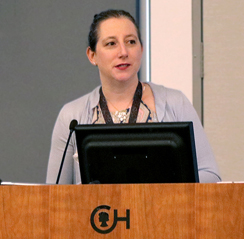
Dr. Falk described her pre-clinical studies of drug therapies in animal models of mitochondrial complex I disease. In the first phase of this work, her team found a series of drug candidates that were effective in improving the lifespan of microscopic worms, C. elegans, with mitochondrial defects equivalent to those that occur in subsets of human disease. The next phase of her research is extending these studies into a small vertebrate animal, zebrafish. But taking promising drugs from animal models into traditional clinical trials to evaluate whether they benefit human patients with mitochondrial disease is difficult because few patients share the same genetic subtype of disease, and often their clinical symptoms and treatment goals vary.
In order to expedite precision medicine for mitochondrial diseases and other rare disorders, Dr. Falk encouraged her fellow scientists to consider a new paradigm of conducting research based on “n-of-1 trials.” This strategy is a clinical trial in which an individual patient is the single participant, and the study aims to objectively assess and make an informed decision about the best course of therapy depending on the patient’s unique data and circumstances. This is an emerging approach recognized as having merit for rare disease by the FDA, and it will require the collaboration and engagement of diverse parties, from academia to pharma to regulatory agencies and patients themselves, to design, fund, and effectively implement.
Optimizing Genome Editing
The Symposium’s keynote address by J. Keith Joung, MD, PhD, pathologist and associate chief of pathology at Harvard Medical School, delved into another novel research paradigm: the remarkable genome editing method known as CRISPR (clustered regularly interspaced short palindromic repeats), which was named Science's 2015 Breakthrough of the Year.
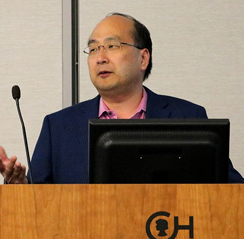
Dr. Joung spoke in detail about one of the biggest challenges researchers face in genome editing: specificity. When scientists utilize CRISPR-Cas9 – which is one of the more commonly used CRISPR systems – a molecule called Cas9 functions like a microscopic set of scissors to slice into DNA strands at the place that scientists would like to edit. Scientists can then go in and alter the DNA by adding, taking away, or manipulating its pieces. What happens, however, when CRISPR inadvertently snips and clips parts of the genome that it shouldn’t? These so-called “off-targets” occur at parts of the genome that might look a lot like the target sites, but aren’t – thus potentially messing with a scientist’s investigation.
“You don’t want to attribute a phenome to an off-target because of the possible effect,” said Dr. Joung, using the example of cancer risk. What if scientists unintentionally silence a gene that suppresses tumors, or activate one that leads to cancer?
To potentially address the problem, Dr. Joung’s lab designed a technology called GUIDE-SEQ, which marks all of the places in the genome where a break in the DNA occurs, thus creating a “map” for researchers to follow when trying to find off-targets. While popular coverage of CRISPR sometimes skips talking about the risk of off-targets, Dr. Joung explained the importance of acknowledging that even breakthrough tools can go wrong.
“This must be done as part of an overall safety evaluation in research,” he said. “It may be challenging for the researcher, but we owe it to patients to do the best possible job to define these risks.”
Advancing Novel Therapeutics and Devices
The Symposium’s afternoon sessions followed Dr. Joung’s theme of optimizing existing discoveries to drive novel impact. In the third session, titled “Advancing CHOP’s Leadership in Novel Therapeutics and Device Development,” researchers shared different ways we can build on research in thrombosis, cancer, neurosurgery, and surgical devices.
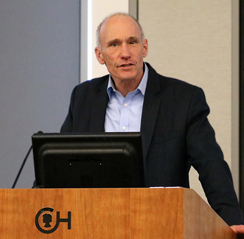
Guest speaker Carl June, MD, director of the Center for Cellular Immunotherapies at Penn, discussed the past and future of immunotherapy in “CAR T-Cells Enter Mainstream Oncology.” His lecture hinged on the question of whether CAR T-cell therapy – which involves a lot of work even in simply harvesting a patient’s cells – was worth it. After telling the story of Emily Whitehead, who is now cancer-free for almost five years, then outlining the subsequent explosion of successful CAR T-cell trials around the world, Dr. June concluded that “clearly, the juice is worth the squeeze.”
Dr. June also discussed the future of immunotherapy, which may very well include the use of CRISPR CAS/9 in CAR T-cell therapy. After harvesting T-cells from a patient, scientists can use gene editing to turbocharge the cells for more optimal cancer-killing effects before re-introducing the cells back into the patient’s body. These edited CAR T-cells may even have a stronger effect on solid tumors since currently, CAR T-cell therapy appears to work better in blood-based cancers, like acute lymphoblastic leukemia.
Promoting Precision Health Research
The fourth and final session, “Developing Breakthrough Precision Health Research,” sent questions firing across the room after each talk. Five researchers shared ways in which precision health, defined as the right intervention for the right patient at the right time, can be applied to a various research subjects including violence prevention at schools, primary care, environmental data, cancer, and health equity.
In this final talk, Tiffani J. Johnson, MD, an attending physician in the department of Emergency Medicine at CHOP, spoke about her recent research findings in implicit racial bias, defined as an unconscious positive or negative attitude toward children of a certain race. Her team of researchers found that in a study of 91 pediatricians in a large emergency department, about 91 percent held pro-white/anti-black bias, according to Child Race Implicit Association Tests.
Dr. Johnson suggested that a precision medicine approach could help improve minority care, and she used the example of sickle cell disease (SCD) and morphine responses. Currently, studies show a wide variation in how children of different races respond to pain, with minority children tending to experience a higher pain burden and requiring more analgesic. In some cases, this can lead to the harmful classification of minorities as “drug-seekers.”
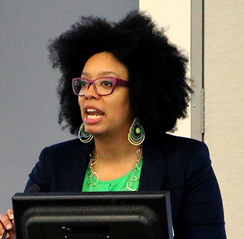
In order to better understand this variation in clinical response – and alleviate unnecessary suffering – Dr. Johnson shared research being conducted by Dr. Angela Ellison that combines genomic information with a rigorous prospective study of morphine response in a large cohort of children with SCD from all races. Researchers can then predict how children with different gene makeup respond.
According to Dr. Johnson, better diagnostic and therapeutic tools will result in reduced clinical uncertainty, which results in decreased impact of bias which, finally, results in reduced disparities.
“How can we make sure vulnerable populations are getting equal opportunity to the best health possible?” Dr. Johnson asked. “Precision medicine can ensure we’re delivering the right interventions to right patients in the right matter, allowing all children equal access to opportunities to attain the highest quality of well-being.”
The Symposium wrapped up with a quick thank you address from Symposium planning committee members Timothy P.L. Roberts, PhD, vice chair of research in Radiology and a professor of Radiology at Penn; Flaura K. Winston, MD, PhD, founding director of the Center for Injury Research and Prevention, and professor of Pediatrics at Penn, and Dr. Anderson to everyone involved, followed by a cocktail reception.
Really cool stuff, indeed.
The Office of Responsible Research Training at the Research Institute sponsored the 2017 Research Scientific Symposium.